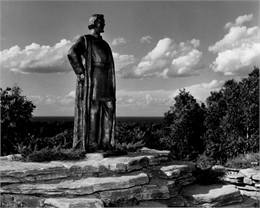Was Nicolet Really the First European in Wisconsin?
An Unreliable Text and Other Evidence

Jean Nicolet Statue, 1951
Jean Nicolet Monument by Bedore. Greenbay, 1951. View the original source document: WHI 39915
Around the state, thousands of children are taught that Jean Nicolet was the first European to set foot in Wisconsin. But evidence indicates he was actually the second white person to visit Wisconsin.
Samuel de Champlain
Nicolet (1598-1642) was a protege of Samuel de Champlain (1567-1635), who sent him west to live with the Indian tribes near Lake Huron, so he could learn their languages and serve as an interpreter. In 1634 Champlain assigned Nicolet to investigate reports of salt water in the far west. On the trip, Nicolet met the Ho-Chunk at Red Banks, just north of modern UW-Green Bay.
But Nicolet was only one of Champlain's young assistants. Another, Etienne Brule (1592-1632) actually visited Wisconsin before Nicolet — approximately a year after the Pilgrims landed at Plymouth Rock.
Etienne Brule

Voyages of Samuel de Champlain
The Wisconsin portion of Champlain's 1632 map. The western portion is based on verbal reports by Champlain's protege Etienn Brule, the only European thought to have visited the western Great lakes before Jean Nicolet in 1634. Champlain had never personally traveled to the far west, so the cartographer erroneously put Green Bay — the Bay of Puants — north of Sault Ste. Marie, rather than south of it. Ca. 1880 facsimile of the original 1632 map. View the original source document: WHI 27032
Brule journeyed to the far West with Huron guides in 1622 or 1623, possibly going completely around Lake Superior. Unlike Nicolet in 1634, there was no one to communicate Brule's adventures to the public. He described his journey only to Champlain and to author Gabriel Sagard-Théodat. The only evidence of his trip consists of two documents. One is a depiction of Lake Superior on a map that Champlain published in 1632; the other is Sagard's handful of scattered references in a book published after Brule was killed when he offended his Huron hosts.
The western portion of Champlain's 1632 map can be viewed through the Historical Society's "Turning Points in Wisconsin History" digital collection. Champlain never personally traveled to the region, so the map is based on verbal reports and is wildly inaccurate by modern standards. It shows Lake Superior — "Grand Lac" — coming together with Lake Michigan — "Mer Douce" — and shows Sault St. Marie between them. Green Bay — "Nation des Puans," a French name for the Ho-Chunk — is depicted above Lake Michigan, either due to Champlain's mis-understanding or the mapmaker's. But the general shape of both lakes is recognizable and locating and naming the Ho-Chunk at Green Bay is accurate.
Histoire du Canada
The other evidence of Brule's visit is Sagard's book "Histoire du Canada, et Voyages que les Frères Mineurs Recollects y Ont Faicts pour la Conversion des Infidèles depuis l'an 1615" published in Paris in 1636. It gives second-hand versions of what Brule saw, in Sagard's words. Its references are few and very vague. Though much of it is plausible, the distances stated are impossible and the exact dates of the trip are unrecorded. You can read Sagard's work — in English or French — at "Turning Points in Wisconsin History."
Based on Sagard's text alone, it's not entirely clear that Brule reached Wisconsin. But when its details are taken in light of those on Champlain's map of 1632 — before Nicolet set out for Wisconsin — it appears that Brule was probably the first European to reach the state. But neither Brule nor Nicolet discovered Wisconsin. The Menominee, Lakota, Ho-Chunk and Ojibwe had been here for many generations before them.
Learn More
See more about Etienne Brule.
